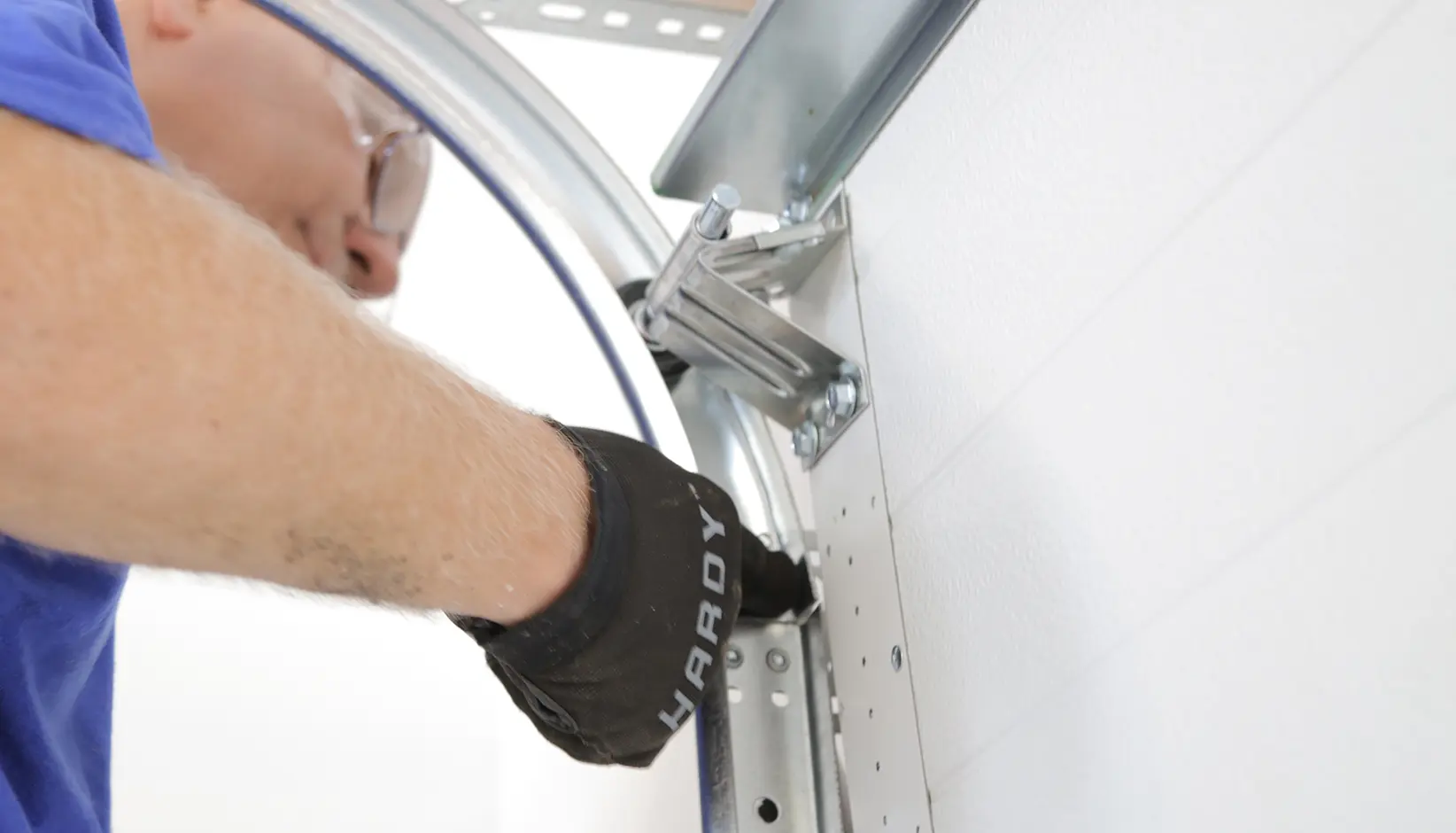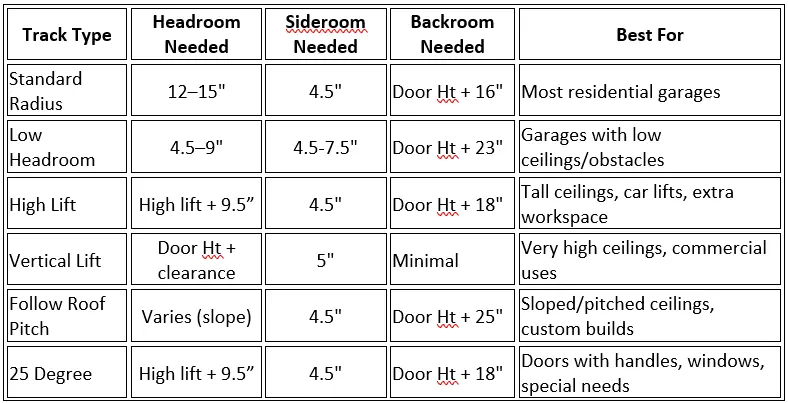Residential Garage Door Track Options

The garage door track plays a key role in supporting the weight of your door and guiding it smoothly every time you open or close it. Reliable garage door rails are what make steady, quiet movement possible—without them, daily operation quickly becomes a hassle. In this guide, you’ll find a straightforward breakdown of garage door track types and their specifications, including important factors like garage door headroom, garage door sideroom, and garage door backroom. Whether you’re replacing an old door or installing something new, you’ll have the details you need to choose the right track.
Garage door tracks do a lot of heavy lifting—literally. These rails support the full weight of the door, guiding it as it opens and closes so everything moves smoothly and safely. If you’ve ever struggled with a door that feels stuck or wobbly, there’s a good chance the garage door track is to blame.
The importance of proper track selection goes beyond convenience. The right garage door rails help prevent uneven wear and reduces stress on the opener and other hardware, extending the life of your entire system. Using the wrong track can lead to unsafe operation, premature component failure, and even property damage. Damaged or misaligned tracks are a common source of problems and should never be ignored.
What is garage door headroom?
Headroom is the clear, vertical space between the top of your garage door and the ceiling or any objects directly above it. Measuring garage door headroom accurately means starting at the highest point of the closed garage door and going straight up to the lowest hanging obstacle—this could be a beam, duct, light fixture, or pipe. Grab a tape measure and check this distance in several spots to make sure there’s enough room across the entire width of the door.
Garage door headroom plays a big part when selecting garage door track types and ensuring the right garage door track specifications. That’s because this space needs to fit not just the straight track sections, but also the curved part of the track that guides the door overhead. In addition, springs (either extension or torsion) and the garage door opener’s motor all require dedicated space above the door. If your headroom is limited, you’ll need to look at specialized track options designed for low-clearance garages. Ignoring headroom can lead to installation headaches, poor operation, or even the need to rework your garage ceiling.
What is garage door sideroom?
Sideroom is the amount of horizontal space available on each side of your garage door, measured from the inside edge of the door opening to the nearest wall or obstruction. To measure garage door sideroom, use a tape measure and record the distance at multiple points along the height of the opening, since pipes, storage, or uneven walls can sometimes get in the way.
This extra space is more important than it might seem. Garage door track types rely on enough sideroom to fit the vertical rails, track brackets, and the hardware that keeps everything steady. The available garage door sideroom also determines what kind of springs—extension or torsion—can be installed, since these components often sit alongside the track. Not enough sideroom, and you might have to choose different garage door track specifications or spring systems to ensure safe, trouble-free operation.
What is garage door backroom?
Backroom is the measurement from the garage door opening, following the ceiling to the back wall of your garage. It’s the total length needed for your garage door to fully retract along the garage door track when open. To measure garage door backroom, start at the garage door and run your tape measure along the ceiling until you reach the farthest wall.
Garage door backroom is essential for making sure the door fits and operates without hitting anything or running out of space. The amount of backroom required depends on the specific garage door track type and specifications, including the length of the door sections and the type of opener you plan to use.
If you have a shorter garage, you may need a track system designed for limited space. This measurement also affects storage options—you don’t want your open door clashing with shelves, bikes, or other items stored in the garage.
Understanding garage door track gauge
Track gauge refers to the width of the garage door rails, and it determines how well your system handles the weight and motion of the door. The three most common garage door track gauges are 1-inch, 2-inch, and 3-inch, each suited for specific uses.
A 1-inch track is lightweight and typically found on semi-trailer or small specialty doors, where space is tight and the door isn’t very heavy. Most homeowners will deal with 2-inch tracks—the go-to standard for residential garage doors—because they offer the right balance of strength and space efficiency for single- or double-car setups.
For heavier or oversized doors, especially in commercial or industrial settings, a 3-inch track is preferred. These heftier rails can support more weight and handle frequent use without bending or warping.
Choosing the right garage door track type is about maximizing your space and meeting the specific needs of your garage. Here’s a breakdown of the most common garage door track options, including their specifications for garage door headroom, garage door sideroom, and garage door backroom.
Standard Radius Track
The standard radius track is the most widely used option in residential settings. This track features a gentle curve that lets your garage door open and rest parallel to the ceiling. Most homes with average ceiling heights and unobstructed garage spaces use this setup—the classic “up and overhead” movement most people expect.
- Headroom requirements: For a 2-inch track, the standard radius is typically 12 or 15 inches. You’ll need at least 12 inches of garage door headroom for a 12-inch radius and 14.25 inches for a 15-inch radius. For 3-inch tracks, used in some heavier residential or light commercial doors, the radius is often larger, and so is the required headroom.
- Sideroom requirements: A minimum of 4.5 inches of garage door sideroom is needed for the track, springs, and brackets to fit without crowding the opening.
- Backroom requirements: You’ll need door height plus 16 inches of garage door backroom for the door to open fully and lie flat along the ceiling.
Low Headroom Track (Front Mount & Rear Mount)
If your garage ceiling is low or you have obstacles above the door, a low headroom track is the answer. This system takes up less vertical space above the door, using a double-track design to let the door start opening horizontally almost immediately.
- Front mount low headroom: The spring is mounted at the front, above the door. This setup typically needs 9 inches of garage door headroom, depending on the opener and track gauge.
- Rear mount low headroom: The spring is placed further back, so only 4.5 inches is required.
- Sideroom requirements: At least 4.5 inches for front mount and 7.5 inches for back mount.
- Backroom requirements: For front mount you’ll need door height plus at least 23 inches and for rear mount you’ll need door height plus 30 inches.
High Lift Track
High lift tracks are designed for garages with extra headroom—think spaces with tall ceilings or where you want the door to rise higher before turning overhead. The vertical portion of the track is extended, so the door travels up the wall longer before rolling back. High lift tracks are a favorite for homeowners who use car lifts, need vertical workspace, or simply want to maximize overhead storage.
- Headroom requirements: You’ll need the high lift plus at least 9.5 inches above the door, but this increases the higher you want the door to rise.
- Sideroom requirements: 4.5 inches or more of garage door sideroom is recommended to accommodate the larger hardware and springs.
- Backroom requirements: Standard backroom (door height plus 18") usually applies but check specific garage door track specifications if you have a unique setup.
Vertical Lift Track
Vertical lift tracks are most common in commercial or industrial garages but are sometimes used in residential settings with extremely high ceilings like Clopay’s VertiStack® Avante®. Instead of curving back, the track runs straight up the wall, so the door rises vertically and stays close to the wall when open.
- Headroom requirements: Vertical lift systems need significant garage door headroom, typically equal to the door height plus extra clearance for the hardware.
- Sideroom requirements: At least 5 inches of garage door sideroom is necessary for the larger track and spring assemblies.
- Backroom requirements: Vertical lift tracks require less garage door backroom since the door doesn’t need to roll back over vehicles or equipment.
Follow Roof Pitch Track
If your garage has a sloped or pitched ceiling, a follow roof pitch track is the smart way to keep your workspace open and avoid awkward gaps. These tracks mirror the angle of your roof, allowing the door to rise and rest parallel with the slope and are a popular option for garages with architectural quirks or custom designs.
- Headroom requirements: Varies based on slope, but generally a bit more than standard radius tracks to fit the angled rails.
- Sideroom requirements: At least 4.5 inches of garage door sideroom is recommended to fit the custom brackets and track hardware.
- Backroom requirements: Door height plus 25 inches is a good guideline but check manufacturer specs for your door and pitch.
25 Degree Track
A 25 degree track is a specialized option for situations where you need to avoid handles, windows, or other door features that might interfere with the standard radius. By increasing the angle, the track keeps the door clear of these obstacles as it opens.
- Headroom requirements: High lift plus 9.5 inches.
- Sideroom requirements: 4.5 inches or more is recommended to fit the modified track shape.
Choosing the right garage door track type starts with knowing your space and your needs. Begin by measuring your available garage door headroom, garage door sideroom, and garage door backroom. If your ceiling is standard height and flat, a standard radius track is usually the best fit. For garages with minimal headroom, look for low headroom tracks—front or rear mount depending on your spring configuration. If you have a tall ceiling, high lift or vertical lift tracks can maximize vertical workspace, keeping your garage door out of the way. For sloped ceilings, a follow roof pitch track will match the angle and preserve your overhead storage.
Next, consider how you plan to use your garage. Need more room above for a car lift or storage? High lift or vertical lift tracks are ideal. Want to avoid interference with handles or windows? A 25 degree track might be the answer. Always check that your chosen garage door rails and hardware meet the garage door track specifications for your setup. The right fit gives you smooth, safe operation and fewer headaches down the road.
Garage Door Track Types: Quick Comparison

Getting the right garage door rails and track type is about more than just fit—it’s about ensuring quiet, safe, and dependable performance for years to come. As you’ve seen, knowing your garage door headroom, sideroom, and backroom, along with the various garage door track types and specifications, is essential in picking the right system for your space and needs.
Professional installation is just as important as choosing the right components. A Clopay dealer can assess your garage, help you navigate the options, and install your garage door track and rails for optimal safety and performance. For more information, inspiration, and expert guidance, reach out to a local dealer.

